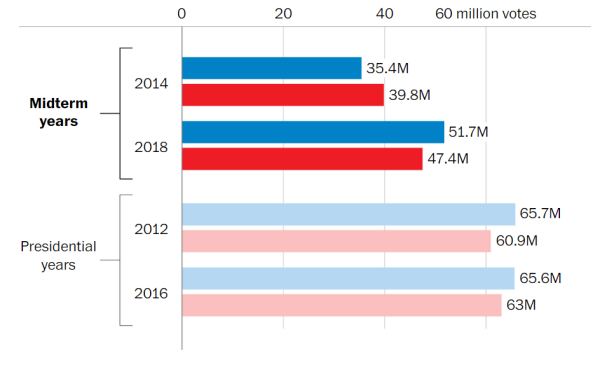Sam Seitz
Evan and I are recording a podcast on this later tonight, so you can look forward to a much more detailed analysis of the midterms then. However, here are my key takeaways from Tuesday night.
1. This was a blue wave by just about any indicator. Democrats picked up nearly 40 seats in the House (we don’t know for sure because a few races still have yet to be called), which is a massive number. Moreover, they fought the GOP to a near stalemate in the Senate, probably losing only two seats despite having to defend 24 (10 of which are in states Trump won “bigly” in 2016). Many Democrats are, quite surprisingly, decrying the Senate “popular vote” disparity, but the numbers actually tell a different story: Democrats won 66% of the Senate seats up for reelection this year despite getting just under 60% of the popular vote! Not that this matters, as the Senate popular vote is a stupid, meaningless statistic. The House popular vote tells a similar story; the Democrats won it by around 7.5%, which is a greater margin than the wave elections of 1994 and 2010.
2. It’s amazing how little faith people seem to have in the electoral process. With allegations from the Democrats of rampant voter suppression and accusations from the Republicans of massive voter fraud, it seems that nobody trusts officials to fairly oversee elections. Of course, some of these concerns seem valid, especially in my home state of Georgia. Nevertheless, the proliferation of conspiracy theories about the election bodes poorly for the future of American democracy.
3. This election will not seriously impede Trump. There will be far more oversight hearings, which are sorely needed, but that’s about it. The Senate has most of the power when it comes to foreign policy and Executive appointments, and that body has probably become Trumpier due to the loss of people like Flake and Corker. Trump is also cleaning house in the Executive, likely in an effort to interfere with the Mueller investigation. As a result, I simply don’t see all that much changing over the next two years.
4. Trump has become an incredibly polarizing and mobilizing figure. The turnout in this past midterm was astoundingly high, and it even approached presidential election levels in some states. The interesting thing, though, was that both Republicans and Democrats showed up in force. And while Democrats came out in greater numbers, demographic breakdowns reveal some interesting trends. The youth vote stayed constant as a percentage of the overall voting population, for example, while the elderly actually made up a greater share of the electorate (26% compared to 23% in 2016).

5. As I suspected, running far-left candidates was not a guaranteed road to victory for the Democrats. Gillum lost (absent some crazy recount results), for example, and so did a fair number of the more radical House candidates. Certain liberal ballot initiatives, such as California’s rent control initiative and Washington’s carbon tax plan, also failed. The lesson is not to run only centrist Democrats: They did poorly in Missouri, Tennessee, and North Dakota. Instead, it is to realize that nationalizing politics and adopting purity tests will not lead to success at the ballot box.
